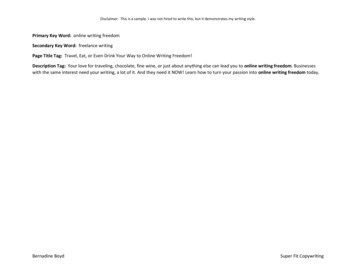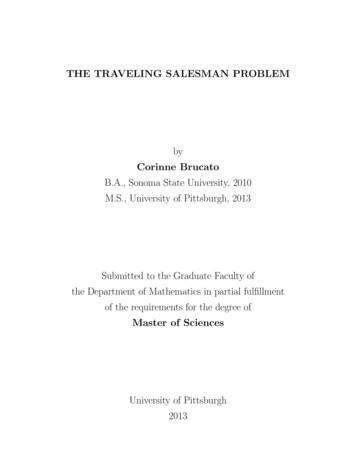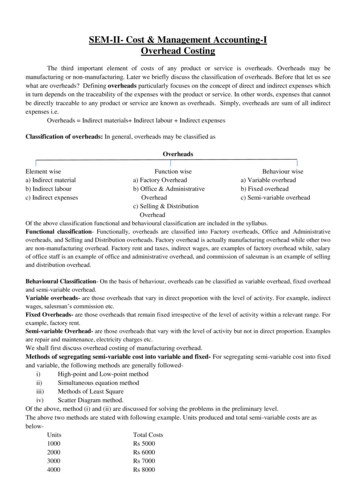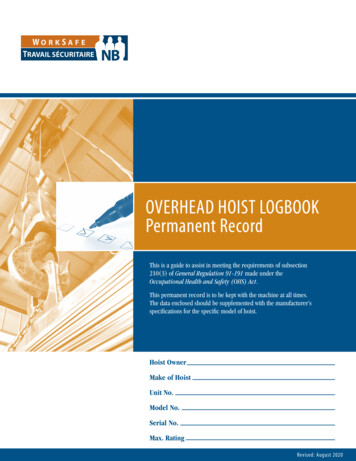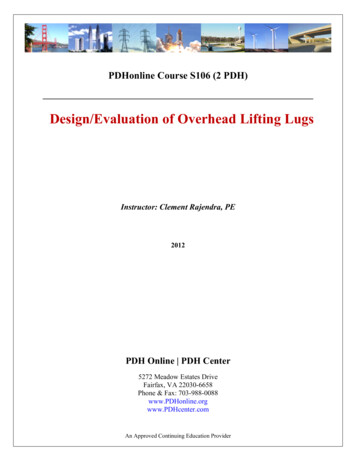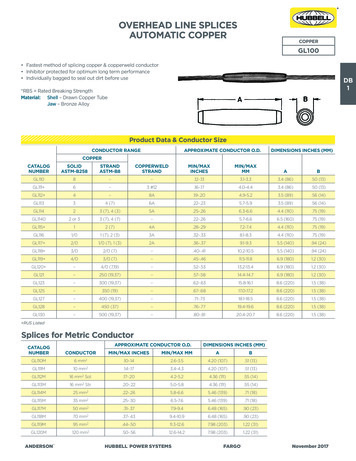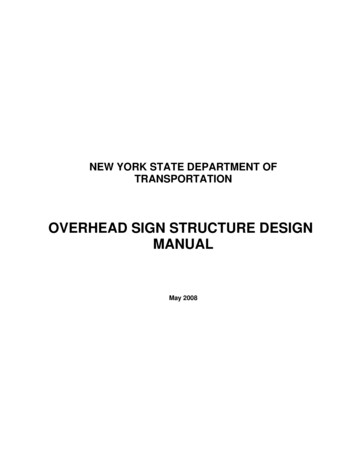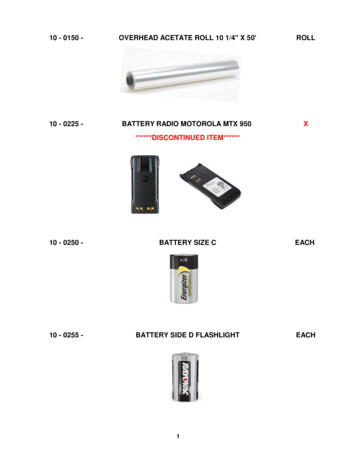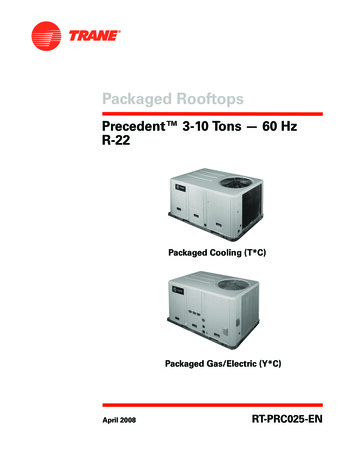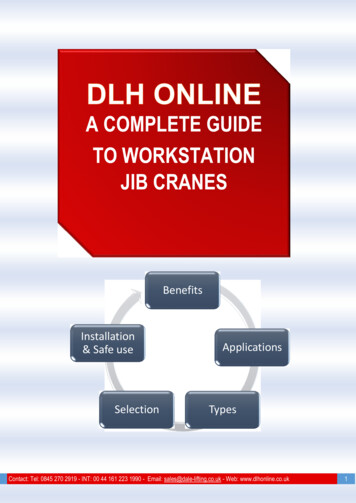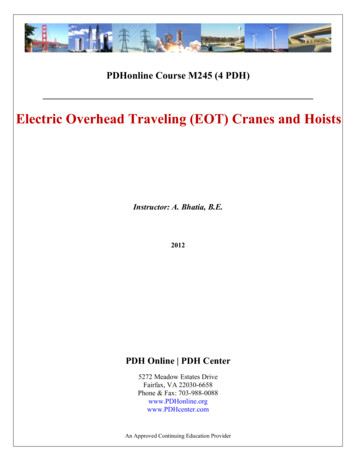
Transcription
PDHonline Course M245 (4 PDH)Electric Overhead Traveling (EOT) Cranes and HoistsInstructor: A. Bhatia, B.E.2012PDH Online PDH Center5272 Meadow Estates DriveFairfax, VA 22030-6658Phone & Fax: 703-988-0088www.PDHonline.orgwww.PDHcenter.comAn Approved Continuing Education Provider
www.PDHcenter.comPDH Course M245www.PDHonline.orgElectric Overhead Traveling (EOT) Cranes and HoistsCourse ContentPage 1 of 83
www.PDHcenter.comPART – 1PDH Course M245www.PDHonline.orgGENERAL INTRODUCTIONIn this section we discuss the following:!"General Overview!"Type of Overhead Cranes!"Basic Components!"Specifying an Overhead Crane!"Basic Crane TerminologyGENERAL OVERVIEWCranes are industrial machines that are mainly used for materials movements in construction sites,production halls, assembly lines, storage areas, power stations and similar places. Their design featuresvary widely according to their major operational specifications such as: type of motion of the cranestructure, weight and type of the load, location of the crane, geometric features, operating regimes andenvironmental conditions.When selecting an electric overhead traveling crane, there are a number of requirements to be taken intoaccount.1)What specifications, codes or local regulations are applicable?2)What crane capacity is required?3)What is the required span?4)What is the lift required by the hoist?5)What will be the duty cycle (usage) of the crane?6)What is the hoist weight? Do you need the use of a second hoist on the bridge crane?7)What is the hook approach required?8)What length of runway system is desired?9)What factors need to be considered in the design of runway and building structure?10)What will the operating environment be (dust, paint fumes, outdoor, etc)?11)What are the necessary crane and trolley speeds?12)What is the supply voltage/phases/amperage?13)What control system is desired?14)Is there existing cranes on the runway?Page 2 of 83
www.PDHcenter.comPDH Course M245www.PDHonline.org15)What safety considerations are to be followed?16)Consider maintenance aspects of the crane.17)Consider other accessories such as lights, warning horns, weigh scales, limit switches, etc.We will address these aspects one by one. But before we discuss further, let’s have a general clarity ofthe terminology used in the overhead crane industry. We shall be discussing here only the ElectricOverhead Traveling (EOT) Cranes.TYPES OF ELECTRIC OVERHEAD CRANESThere are various types of overhead cranes with many being highly specialized, but the great majority ofinstallations fall into one of three categories: a) Top running single girder bridge cranes, b) Top runningdouble girder bridge cranes and c) Under-running single girder bridge cranes. Electric Overhead Traveling(EOT) Cranes come in various types:1) Single girder cranes - The crane consists of a single bridge girder supported on two end trucks. It hasa trolley hoist mechanism that runs on the bottom flange of the bridge girder.2) Double Girder Bridge Cranes - The crane consists of two bridge girders supported on two end trucks.The trolley runs on rails on the top of the bridge girders.3) Gantry Cranes - These cranes are essentially the same as the regular overhead cranes except thatthe bridge for carrying the trolley or trolleys is rigidly supported on two or more legs running on fixedrails or other runway. These “legs” eliminate the supporting runway and column system and connect toend trucks which run on a rail either embedded in, or laid on top of, the floor.4) Monorail - For some applications such as production assembly line or service line, only a trolley hoistis required. The hoisting mechanism is similar to a single girder crane with a difference that the cranedoesn’t have a movable bridge and the hoisting trolley runs on a fixed girder. Monorail beams areusually I-beams (tapered beam flanges).Which Crane should you choose – Single Girder or Double GirderA common misconception is that double girder cranes are more durable! Per the industry standards(CMMA/DIN/FEM), both single and double girder cranes are equally rigid, strong and durable. This isbecause single girder cranes use much stronger girders than double girder cranes. The differencebetween single and double girder cranes is the effective lifting height. Generally, double girder cranesprovide better lifting height. Single girder cranes cost less in many ways, only one cross girder isrequired, trolley is simpler, installation is quicker and runway beams cost less due to the lighter cranedead weight. The building costs are also lower.However, not every crane can be a single girder crane. Generally, if the crane is more than 15 ton or thespan is more than 30m, a double girder crane is a better solution.The advantages and limitations of Single / double girder cranes are as follows:Single Girder CranesoSingle girder bridge cranes generally have a maximum span between 20 and 50 feet with amaximum lift of 15-50 feet.oThey can handle 1-15 tonnes with bridge speeds approaching a maximum of 200 feet per minute(fpm), trolley speeds of approximately 100 fpm, and hoist speeds ranging from 10-60 fpm.Page 3 of 83
www.PDHcenter.comPDH Course M245www.PDHonline.orgoThey are candidates for light to moderate service and are cost effective for use as a standby(infrequently used) crane.oSingle girder cranes reduce the total crane cost on crane components, runway structure andbuilding.Double Girder CranesoDouble girder cranes are faster, with maximum bridge speeds, trolley speeds and hoist speedsapproaching 350 fpm, 150 fpm, and 60 fpm, respectively.oThey are useful cranes for a variety of usage levels ranging from infrequent, intermittent use tocontinuous severe service. They can lift up to 100 tons.oThese can be utilized at any capacity where extremely high hook lift is required because the hookcan be pulled up between the girders.oThey are also highly suitable where the crane needs to be fitted with walkways, crane lights, cabs,magnet cable reels or other special equipment.EOT CRANE CONFIGURATION1) Under Running (U/R)2) Top Running (T/R)Under running cranesUnder Running or under slung cranes are distinguished by the fact that they are supported from the roofstructure and run on the bottom flange of runway girders. Under running cranes are typically available instandard capacities up to 10 tons (special configurations up to 25 tons and over 90 ft spans). Under hungcranes offer excellent side approaches, close headroom and can be supported on runways hung fromexisting building members if adequate.The Under Running Crane offers the following advantages:oVery small trolley approach dimensions meaning maximum utilization of the building's width andheight.oThe possibility of using the existing ceiling girder for securing the crane track.Following are some limitations to Under Running Cranes oHook Height - Due to Location of the runway beams, Hook Height is reducedoRoof Load - The load being applied to the roof is greater than that of a top running craneoLower Flange Loading of runway beams require careful sizing otherwise, you can "peel" theflanges off the beamPage 4 of 83
www.PDHcenter.comPDH Course M245www.PDHonline.orgTop Running CranesThe crane bridge travels on top of rails mounted on a runway beam supported by either the buildingcolumns or columns specifically engineered for the crane. Top Running Cranes are the most commonform of crane design where the crane loads are transmitted to the building columns or free standingstructure. These cranes have an advantage of minimum headroom / maximum height of lift.BASIC CRANE COMPONENTSTo help the reader better understand names and expressions used throughout this course, find below is adiagram of basic crane components.Page 5 of 83
www.PDHcenter.comPDH Course M245www.PDHonline.org1)Bridge - The main traveling structure of the crane which spans the width of the bay and travels in adirection parallel to the runway. The bridge consists of two end trucks and one or two bridge girdersdepending on the equipment type. The bridge also supports the trolley and hoisting mechanism forup and down lifting of load.2)End trucks - Located on either side of the bridge, the end trucks house the wheels on which theentire crane travels. It is an assembly consisting of structural members, wheels, bearings, axles,etc., which supports the bridge girder(s) or the trolley cross member(s).3)Bridge Girder(s) - The principal horizontal beam of the crane bridge which supports the trolley and issupported by the end trucks.4)Runway - The rails, beams, brackets and framework on which the crane operates.5)Runway Rail - The rail supported by the runway beams on which the crane travels.6)Hoist - The hoist mechanism is a unit consisting of a motor drive, coupling, brakes, gearing, drum,ropes, and load block designed to raise, hold and lower the maximum rated load. Hoist mechanismis mounted to the trolley.7)Trolley - The unit carrying the hoisting mechanism which travels on the bridge rails in a direction atright angles to the crane runway. Trolley frame is the basic structure of the trolley on which aremounted the hoisting and traversing mechanisms.8)Bumper (Buffer) - An energy absorbing device for reducing impact when a moving crane or trolleyreaches the end of its permitted travel, or when two moving cranes or trolleys come into contact.This device may be attached to the bridge, trolley or runway stop.Page 6 of 83
www.PDHcenter.comPDH Course M245www.PDHonline.orgRefer to Annexure -A for definition of technical terms.SPECIFYING AN OVERHEAD CRANEPARAMETERS NEEDED FOR SPECIFYING AN OVERHEAD CRANE1Crane capacity (tons)2Required lifting height (in.)3Runway height (ft. & in.)#" Hoist Speed (ft per minute)4Clearance Required (ft. & in.)#" Bridge Travel Speed (ft per min)5Building Width, Clear Span (ft. & in.)6Building Height (ft. & in.)7Runway Size & Length (in. & ft)8Hook Approach & End Approach (ft. & in.)Other Desired Information#" Trolley Travel Speed (ft per min)#" Electrical Requirements (Festoon orConductor Bar)#" Control RequirementsESSENTIAL PARAMETERS FOR SPECIFING EOT CRANESTo select correct crane envelope that will fit in the building foot print, the user must identify and pass onthe following key information to the supplier:1)Crane Capacity * - The rated load, the crane will be required to lift. Rated load shall mean themaximum load for which a crane or individual hoist is designed and built by the manufacturer andshown on the equipment identification plate.2)Lift Height - The rated lift means the distance between the upper and lower elevations of travel ofthe load block and arithmetically it is usually the distance between the beam and the floor, minus theheight of the hoist. This dimension is critical in most applications as it determines the height of therunway from the floor and is dependent on the clear inside height of the building. Do not forget toinclude any slings or below the hook devices that would influence this value.Page 7 of 83
www.PDHcenter.comPDH Course M245www.PDHonline.org3)Runway Height – The distance between the grade level and the top of the rail.4)Clearance- The vertical distance between the grade level and the bottom of the crane girder.5)Clear Span- Distance between columns across the width of the building. Building width is defined asthe distance from outside of eave strut of one sidewall to outside of eave strut of the oppositesidewall. Crane Span is the horizontal center distance between the rails of the runway on which thecrane is to travel. Typically distance is approximate to 500mm less than the width of the building.How much span a crane requires depends on the crane coverage width dictated by the application.(According to the span and the maximum load handling capacity, the crane steel structure isselected to be either a single or double girder crane construction).6)Building Height- Building height is the eave height which usually is the distance from the bottom ofthe main frame column base plate to the top outer point of the eave strut. Eave height is thedistance from the finished floor to the top outer point of the eave strut. There must be a safetydistance between the top edge of the crane runway rail and the first obstacle edge in the building(for example roof beams, lights and pipes).7)Runway Length- The longitudinal run of the runway rail parallel to the length of the building.8)Hook approaches - Maximum hook approach is the distance from the wall to the nearest possibleposition of the hook. The smaller the distance is, the better can the floor area be utilized. Alwayscheck which crane gives optimum hook approaches and when combined with the true lift of the hoistyou can utilize most of the available floor space. This is also termed as side hook approach.End Approach – This term describes the minimum horizontal distance, parallel to the runway,between the outermost extremities of the crane and the centerline of the hook.9)Bridge, Trolley and Lift Speeds - The rate at which the bridge or trolley travels or at which the hoistlifts is usually specified in feet per minute or FPM. The crane operating speeds are selected to allowsafe operation whilst using the pendant. Dual operating speeds, normally a fast and slow speed witha ratio of 4:1 are commonly used but for optimum control a variable speed control system is stronglyrecommended.10)Electrical Requirements - Specify the circuit voltage shall not exceed 600 volts for AC or DC current.Ideally 480 volt, 3 phase, 60 hertz for US requirements. The runway power is usually by conductorbar and hoisting trolley by festoon cable. (refer section 6 for details)11)Control Requirements - The control circuit voltage at pendant pushbuttons shall not exceed 150volts for AC and 300 volts for DC. Other control options including radio control, free-floating pendant(festooned) or hoist-mounted pendant requirements must be stated.Other than addressing the above parameters,
PDHonline Course M245 (4 PDH) Electric Overhead Traveling (EOT) Cranes and Hoists 2012 Instructor: A. Bhatia, B.E. PDH Online PDH Center 5272 Meadow Estates Drive Fairfax, VA 22030-6658 Phone & Fax: 703-988-0088 www.PDHonline.org www.PDHcenter.com An
